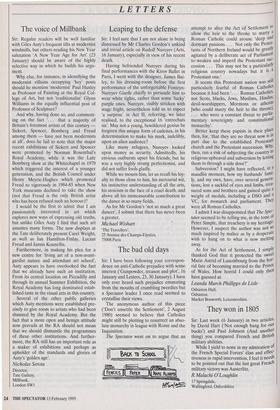LETTERS The voice of Millbank
Sir: Regular readers will be well familiar with Giles Auty's frequent tilts at modernist windmills, but others reading his New Year salutation 'A New Year Age for Art' (23 January) should be aware of the highly selective way in which he builds his argu- ment.
Why else, for instance, in identifying the modernist villains occupying 'key' posts should he mention 'modernist' Paul Huxley as Professor of Painting at the Royal Col- lege of Art, but not 'traditionalist' Glynn Williams in the equally influential post of Professor of Sculpture?
And why, having done so, and comment- ing on the fact . that a majority of Britain's foremost artists of this century — Sickert, Spencer, Bomberg and Freud among them — have not been modernists at all', does he fail to note that the major recent exhibitions of Sicken and Spencer were promoted by Norman Rosenthal's Royal Academy, while it was the Late Bomberg show at the Whitechapel in 1979 which triggered the interest of a younger generation, and the British Council under Henry Meyric-Hughes which promoted Freud so vigorously in 1984-85 when New York museums declined to take the show (not that Freud is the only British artist who has been refused such an honour)?
I would be the first to admit that I am passionately interested in art which explores new ways of expressing old truths, but unlike Giles Auty I find that such art assumes many forms. The new displays at the Tate deliberately present Carel Weight, as well as Ian Hamilton-Finlay, Lucian Freud and Jannis Kounellis.
Furthermore, in making his plea for a new centre for 'living art of a non-avant- gardist nature and attendant art school', Auty appears to have overlooked the fact that we already have such an institution. From its central location on Piccadilly and through its annual Summer Exhibition, the Royal Academy has long dominated estab- lished taste in the visual arts in this country.
Several of the other public galleries which Auty mentions were established pre- cisely to give room to artists who had been shunned by the Royal Academy. But the fact that a more open and benign attitude now prevails at the RA should not mean that we should dismantle the programmes of these other institutions. And further- more, the RA still has an important role as a maker of exhibitions and perhaps as upholder of the standards and glories of Auty's 'golden age'.
Nicholas Serota
Director, Tate Gallery, Millbank, London SW1


















































 Previous page
Previous page